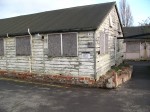 After a year of raising £7.4 million from private donors and a large Heritage Lottery Fund grant, in fall of 2012 the Bletchley Park Trust began Project Neptune, a program of restoration on the derelict structures in which Alan Turing and the Bletchley Park team worked to break the German Enigma Code during World War II. Phase One of the project was focused on the restoration of Huts 3 and 6, used to break German Army and Air Force codes, and Block C, an open-floorplan building that held the Hollerith punch-card machines which analyzed encrypted messages. The aim was to restore the Huts and Block to their wartime condition, not new as they were when first constructed in 1939 and 1940.
After a year of raising £7.4 million from private donors and a large Heritage Lottery Fund grant, in fall of 2012 the Bletchley Park Trust began Project Neptune, a program of restoration on the derelict structures in which Alan Turing and the Bletchley Park team worked to break the German Enigma Code during World War II. Phase One of the project was focused on the restoration of Huts 3 and 6, used to break German Army and Air Force codes, and Block C, an open-floorplan building that held the Hollerith punch-card machines which analyzed encrypted messages. The aim was to restore the Huts and Block to their wartime condition, not new as they were when first constructed in 1939 and 1940.
Block C was used by various government departments for decades after the war and had been divided with internal walls. It suffered significant water damage since it fell into disuse and trees were growing out of the roof. More than 5,000 of the original acoustic ceiling tiles were recovered and another 8,000 period tiles found in the United States to rebuild the roof. The walls were all knocked down to return it to its original floorplan and the water damage repaired. Block C is now a visitor center.
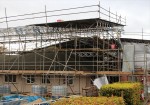 Hut 6, where the Enigma messages were decoded and translated, and Hut 3, where the translated message were analyzed for their intelligence, were close to crumbling. They were built to be temporary structures easily demolished after the war and the fact that they survived at all is a miracle. Hut 6 was particularly battered by decades of weather, with its west side almost entirely rotted. The gutters and downspouts were so damaged rain water soaked into the walls for decade. The rotted wood boards were replaced with floorboards from Fawley Court in Henley on Thames, a historic country estate requisitioned for use as a military intelligence school during the war. Fawley Court also supplied shiplap boarding to replace the siding on the exterior of the huts. The original radiators were restored and reinstalled (connected to new pipes, of course) and paint colors were precisely matched to the original wartime colors.
Hut 6, where the Enigma messages were decoded and translated, and Hut 3, where the translated message were analyzed for their intelligence, were close to crumbling. They were built to be temporary structures easily demolished after the war and the fact that they survived at all is a miracle. Hut 6 was particularly battered by decades of weather, with its west side almost entirely rotted. The gutters and downspouts were so damaged rain water soaked into the walls for decade. The rotted wood boards were replaced with floorboards from Fawley Court in Henley on Thames, a historic country estate requisitioned for use as a military intelligence school during the war. Fawley Court also supplied shiplap boarding to replace the siding on the exterior of the huts. The original radiators were restored and reinstalled (connected to new pipes, of course) and paint colors were precisely matched to the original wartime colors.
Block C and Huts 3 and 6 opened to the public in June of last year. Hut 11A, one of the huts that housed the Bombe machines developed to decipher the Enigma code, has been restored and is being outfitted for display. Hut 11, the other Bombe hut, is currently in the process of restoration. (Turing’s office in Hut 8 was restored a decade ago.)
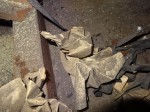 During the work on Hut 6 in September of 2013, restorers discovered crumpled sheets of paper under the roof. In remarkable condition considering the walls around them were falling apart, the notebook pages had been stuffed into the notoriously drafty, uninsulated walls of the hut. All notes related to codebreaking were supposed to be destroyed as per wartime regulations, so it underscores the rudimentary conditions in the huts that the cryptographers violated security protocols to keep out the cold. The papers
During the work on Hut 6 in September of 2013, restorers discovered crumpled sheets of paper under the roof. In remarkable condition considering the walls around them were falling apart, the notebook pages had been stuffed into the notoriously drafty, uninsulated walls of the hut. All notes related to codebreaking were supposed to be destroyed as per wartime regulations, so it underscores the rudimentary conditions in the huts that the cryptographers violated security protocols to keep out the cold. The papers 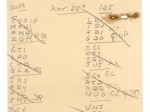 were immediately frozen to keep them from decaying and then cleaned and conserved for display. The discovery of the documents has been announced now that the conservation is complete.
were immediately frozen to keep them from decaying and then cleaned and conserved for display. The discovery of the documents has been announced now that the conservation is complete.
Bletchley Park’s Director of Learning and Collections, Victoria Worpole, said in a statement:
“It’s quite rare for us to find new paperwork because any that survived is in either our archive, at GCHQ or the National Archive so to find actual materials that were used by the Codebreakers, shoved between beams and cracks in the woodwork is really exciting. We’ve had a conservator work on the materials to make sure we preserve them as best we can. It’s quite interesting to think that these were actual handwritten pieces of codebreaking, workings out. There are some pieces of paperwork that we can’t identify. Nobody seems to be able to work out what they are – we’ve sent things off to GCHQ — and there are a number of items that we’ve yet to understand properly. We’re unveiling a mystery.”
 Among the documents were Banbury sheets, used in a system Turing devised to take advantage of a fault in the wheel design of the Enigma. Cryptographers punched holes representing different ciphers in two sheets of paper. They would then put the sheets on top of each other until the holes aligned. This helped reveal the daily rotor setting of the very challenging naval Enigma machine. Turing called the system Banburismus and the papers Banbury sheets after Banbury, Oxfordshire, where the stationary was made. The Banbury sheets found in Hut 6 are the only examples known to survive.
Among the documents were Banbury sheets, used in a system Turing devised to take advantage of a fault in the wheel design of the Enigma. Cryptographers punched holes representing different ciphers in two sheets of paper. They would then put the sheets on top of each other until the holes aligned. This helped reveal the daily rotor setting of the very challenging naval Enigma machine. Turing called the system Banburismus and the papers Banbury sheets after Banbury, Oxfordshire, where the stationary was made. The Banbury sheets found in Hut 6 are the only examples known to survive.
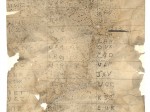 The codebreaking documents and other assorted discoveries made in Hut 6 — parts of an Atlas, a pinboard and an article about fashion — and elsewhere on the property — a fragment of a teapot, glass bottles, bricks from the demolished Block F and a time capsule left inside a door in Hut 11A — are going on display in an exhibition, The Restoration of Historic Bletchley Park, in Hut 12.
The codebreaking documents and other assorted discoveries made in Hut 6 — parts of an Atlas, a pinboard and an article about fashion — and elsewhere on the property — a fragment of a teapot, glass bottles, bricks from the demolished Block F and a time capsule left inside a door in Hut 11A — are going on display in an exhibition, The Restoration of Historic Bletchley Park, in Hut 12.
Fascinating! (But one typo: “where the stationary was made” should be “stationery.”)
These code breakers have always fascinated me, so much so that I have been studying for some time now the Ancient Minoan script writings called Linear B which was deciphered in 1953 by Michael Ventris. So thank you for this most interesting post.
Cryptography fascinated one of my daughters so much as a teen that she read every book she could get her hands on- dozens of them, some very technical. I thought she might become a cryptographer, but she ended up a historian and medievalist. Go figure. A week or so ago over dinner, her daughter (now about the same age) out of the blue began a conversation about cryptography. We all like mystery novels, which are puzzles of a sort; history and codes are just different kinds of puzzles. I think my granddaughter will enjoy reading this post. I totally love that bits of code puzzling were stuffed in the cracks of the hut to stop drafts. Not at all surprising.
We can only presume – and be thankful – that the huts were so cold and wet that mice and wasps stayed away from these precious artifacts!
If it wasn’t for benedict cumberbund and his funny little face, no one would care.
I’m fascinated by the history of Bletchley Park, and really enjoyed this post.
It also turns out that a notebook of Alan Turing’s, inherited by a friend, who has since passed away, is going up for auction in April. A petition is up (British citizens only) to ask for it to be acquired for the UK. As an American, I can’t sign it, but perhaps there are some Brits among your reader who would like to.
The petition: http://epetitions.direct.gov.uk/petitions/74136
Article: http://www.theguardian.com/uk-news/the-northerner/2015/feb/05/campaign-to-buy-alan-turings-notebook-for-the-nation
Auction house press release: http://www.bonhams.com/press_release/18431/
Fascinating!
It might be a good thing they found these papers now. There were a lot of young people working at Bletchley park during the war so maybe there is someone still alive who knows what the unknown papers might be.
Hmm! Perhaps the additional notes and the Banbury sheets will prompt a re-evaluation of descended and co-developed codebreaking methodologies, such as those in the Venona program. There are plenty of “Why do we do it like that, again?” questions that some of this might answer, with careful study.
As a former resident of Banbury Oxon, who grew up in the immediate post WW11 era, I would like to add some other not so well known facts about the links of Bletchley Park with Banbury.
Banbury had a railmay Station known as “Merton Street” (closed by Dr. Beeching) which was a single line railway to Brackley, Buckingham and on to Bletchley.
Banbury was also a well known target for the German Air Force due to the location of an Aluminium Processing Factory there, which was so often targeted that a false factory of timber was built, known as the “Dummy Alley”, and the real factory was effectively camoflaged. What is not so well known,is that less than a mile from this factory was another factory named “Switchgear and Equipment Ltd.” which as its’ name suggests manufactured all types of electrical components. I am guessing that a considerable amount of the components used by Alan Turing to make his Bombes, made their way to Bletchley and then onto Bletchley Park via this little known and mostly insignificant rail line.
Has anyone more information?